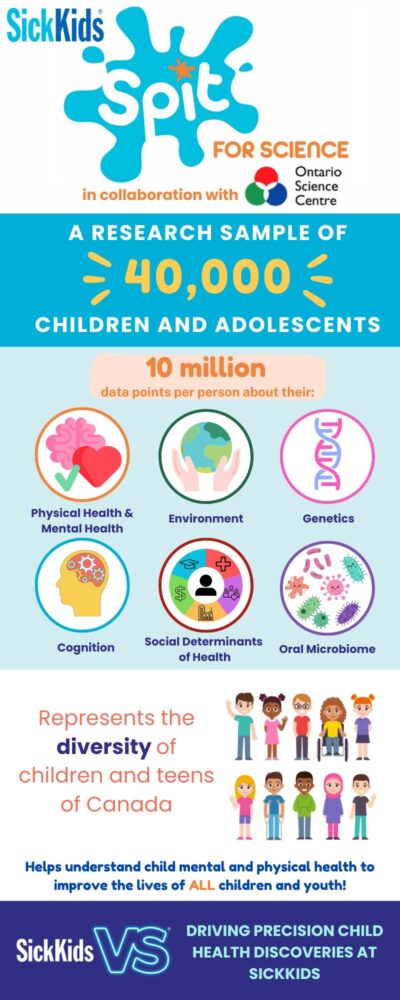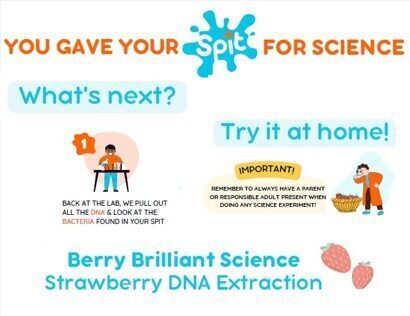A little bit of spit can help us make a healthier world!
Your genes and the environment around you help to shape your physical and mental well-being.
Spit for Science 2
We recruited 40,000 children and adolescents visiting the Ontario Science Centre (OSC) to become Junior Scientists as part of research project called Spit for Science.
We asked our Junior Scientists and their parents to complete questionnaires about behaviour (the way you act), play a computer game to understand cognition (the way you think), as well as physical health and well-being. Using Postal Codes, we have estimated many different aspects of a person’s environment (e.g., how close you live to green space or exposure to air pollution). Finally, we asked our Junior Scientists to spit in a small tube so that we can collect DNA and learn about bacteria in their mouths!
We aim to discover how your genes work with the environment to impact children and teens mental and physical health. In genetic research, we need as many people as possible.
This study is a continuation of Spit for Science 1 that ran at the Ontario Science Centre in 2008-2009. Spit for Science 2 expanded on Spit for Science 1 in four important ways, by:
Recruiting an additional 24,000 new participants
Adding new measures of behaviour and cognition (error detection and sustained attention)
Estimating environmental risks using geospatial mapping of postal codes
Exploring gene X environment interactions across aspects of children and youth mental and physical health;
Looking at how the oral microbiome (bacteria in our mouths) might affect how we think and feel

We are no longer recruiting for this study.
Thank you to everyone who reached out and helped us reach our recruitment goals!
Click Below to Learn More!
Have questions?
For more information, please contact:
Alex Chan,
Clinical Research Project Coordinator
Email: spitfor.science2@sickkids.ca
Principal Investigator & Co-Investigators:
Jennifer Crosbie, PhD (PI)
Russell Schachar, MD (Co-I)
Paul Arnold, MD, PhD (Co-I; University of Calgary)
Christie Burton, PhD (Co-I)
Primary Collaborators:
Paul Peters, PhD (Carleton University)
Lisa Strug, PhD (SickKids)
Andrew Paterson, MD (SickKids)
Stephen Scherer, PhD (SickKids)
Anna Goldenberg, PhD (SickKids)
Jacob Vorstman, MD, PhD (SickKids)
Spit for Science 1
In Spit for Science 1, which ran at the OSC for 16 months between 2008-2009, we collected DNA, mental health information, behavioural and cognitive trait (response inhibition) measures in >17,000 youth. A large subset of the sample has currently has genome-wide microarray data.
Highlights of our results from Spit for Science 1 include:
- The first replicated genome-wide significant risk loci for obsessive compulsive disorder (OCD) traits (Burton et al. 2021)
- The first study of copy number variants (CNVs) associated with mental health and cognitive traits in the general pediatric population (Zarrei et al., 2023)
- Developed and validated a new measure for obsessive-compulsive traits (Park et al., 2016; Burton et al., 2018)
- Demonstrated that genetic risk for clinically diagnosed ADHD are associated with ADHD traits measured in the community (Burton et al., 2019)
- Mapped the development of response inhibition and error processing across development (Crosbie et al., 2013; Dupuis et al., 2019)
- Established the heritability of several mental health traits in the general population (Crosbie et al., 2013; Burton et al., 2018)
Data Access & Collaboration
To access data from Spit for Science 1, contact Christie Burton. Data will soon be available through The Hospital for Sick Children Healthy Kids Biobank. Spit for Science samples are screened for medical and psychiatric conditions and have been used several times as healthy controls for genetic analyses.
Spit for Science Mobile App – Privacy Policy
Publications from
Spit for Science
Click on the Article Title to Learn More!
Dissanayake, A., Dupuis, A., Burton, C., Soreni, N, Peters, P, Gajaria, A, Arnold, P, Schachar, R.J., Crosbie, J,. (2024). Racial/Ethnic Disparities in Youth Mental Health Traits and Diagnoses within a Community-based Sample. Canadian Journal of Psychiatry. March 1. Online ahead of print.
Dissanayake, A., Dupuis, A., Crosbie, J., Burton, C., Schachar, R.J., Levy, T. (2024) Is irritability multidimensional: Psychometrics of The Irritability and Dysregulation of Emotion Scale (TIDES-13). European Journal of Child and Adolescent Psychiatry. Jan 16. Online ahead of print.
Rizeq, J, Burton, C, Arnold, P., & Crosbie, J. (In press). The role of functional impairment in the interplay of seven domains of childhood and adolescent psychopathology: a network approach. Journal of Psychopathology and Clinical Science.
Arnatkeviciute, A , Lemire, M, Morrison, C, Mooney, M, Ryabinin, P, Roslin, Nikolas, NM, Coxon, J, Tiego, J, Hawi, Z, Fornito, A, Henrik, W, , Martinot, J, Martinot, MP, Artiges, E, Garavan, H, Nigg, J, Friedman, N, Burton, C, Schachar, R, Crosbie, J, Bellgrove, M. (2023). Trans-ancestry meta-analysis of genome wide association studies of inhibitory control. Molecular Psychiatry. July 7 Online ahead of print.
Zarrei, M, Burton, C, Engchuan, W, Higginbotham, E, Wei, J, Shaikh, S Roslin, N, … Crosbie, J, Schachar, R, Scherer, SW (2023). Gene copy number variation in pediatric mental illness in the population. Human Molecular Genetics. 32(15): 2411-2421.
Nakua H, Hawco C, Forde NJ, Joseph M, Grillet M, Johnson D, Jacobs GR, Hill S, Voineskos A, Wheeler AL, Lai MC, Szatmari P, Georgiades S, Nicolson R, Schachar R, Crosbie J, Anagnostou E, Lerch JP, Arnold PD, Ameis SH. (2023). Systematic comparisons of different quality control approaches applied to three large pediatric neuroimaging datasets. Neuroimage. 274:120119.
Schachar, R.J., Dupuis, A., Arnold, P.D., Anagnostou, E., Kelley, E., Georgiades, S., Nicholson, R. Burton, C.L., & Crosbie, J. (2023). Autism Spectrum Disorder and Attention-Deficit/Hyperactivity Disorder: Shared or unique neurocognitive impairments? Research on Child and Adolescent Psychopathology. Jan;51(1):17-31.
Lambe, L., Burton, CL.,Schachar, RJ., Hanna, G., Anagnostou E., Kelley, E Nicolson, Arnold, PD., Crosbie J, (2022). Clinical validation of the parent-report Toronto Obsessive–Compulsive Scale (TOCS): A pediatric open-source rating scale. Journal of Child Psychology and Psychiatry Advances, 1(4), e12056.
Schachar, R.J., Dupuis, A., Anagnostou, E., Georgiades, S., Soreni, N., Arnold, P.D., Burton, C.L., Crosbie, J. (2022). Obsessive-compulsive disorder in children and youth: neurocognitive function in clinic and community samples. Journal of Child Psychology and Psychiatry. 63(8): 881-889.
Strom, N. I., Smit, D. J. A., Silzer, T., Iyegbe, C., Burton, C. L., Pool, R., Lemire, M., Crowley, J. J., Hottenga, J.-J., Ivanov, V. Z., Larsson, H., Lichtenstein, P., Magnusson, P., Rück, C., Schachar, R. J., Wu, H. M., Meier, S. M., Crosbie, J., Arnold, P. D., … Cath, D. (2022). Meta-analysis of genome-wide association studies of hoarding symptoms in 27,537 individuals. Translational Psychiatry, 12(1), 479.
Dupuis, A., Mudiyanselage, P, Burton, C.L., Arnold, P.D., Crosbie, J., Schachar, R. (2022). Hyperfocus or Flow? Attentional strengths in Autism Spectrum Disorder. Frontiers in Psychiatry. Sept 16:13:886692.
Burton, CL., Lemire, M., Xiao, B., Corfield, E., …. Schachar, RJ., Crosbie, J., Arnold, PD. (2021). Genome-wide association study of pediatric obsessive-compulsive traits: shared genetic risk between traits and disorders. Translational Psychiatry, 11(1): 91.
Bralten J, Widomska J, Witte W, … Arnold P, Lemire M, Burton CL, Franke B, Poelmans G. (2020). Shared genetic etiology between obsessive-compulsive disorder, obsessive-compulsive symptoms in the population, and insulin signaling. Translational Psychiatry. 10(1):121.
Sinopoli VM, Erdman L, Burton CL, Park LS, Dupuis A, Shan J, Goodale T, Shaheen SM, Crosbie J, Schachar RJ, Arnold PD. (2020). Serotonin system genes and hoarding with and without other obsessive-compulsive traits in a population-based, pediatric sample: A genetic association study. Depression and Anxiety. Aug;37(8):760-770.
Goodman SJ, Burton CL, … Arnold PD, Crosbie J, Schachar R, Weksberg R. (2020). Obsessive-compulsive disorder and attention-deficit/hyperactivity disorder: distinct associations with DNA methylation and genetic variation. Journal of Neurodevelopmental Disorders, 12(1):23.
Sinopoli,V., Erdman, L., Burton, C.L., Park, L.S., Dupuis, A., Shan, J., Shaheen, S-M, Crosbie, J., Schachar, R., Arnold, P. (2019). Serotonin System Genes and Obsessive-Compulsive Trait Dimensions in a Population-Based, Pediatric Sample: A Genetic Association Study. Journal of Child Psychology and Psychiatry. Dec; 60(12):1289-1299.
Burton, CL., Wright, L., Shan, J., Xiao, B., Dupuis, A., Goodale, T., Shaheen, S-M, Corfield, E.C., Arnold. P.D., Schachar, R.J., & Crosbie, J. (2019). SWAN Scale for ADHD Trait-Based Genetic Research: A Validity and Polygenic Risk Study. Journal of Child Psychology and Psychiatry. 60(9): 988-997.
Dupuis, A., Indralingam, M., Chevrier, A., Crosbie, J., Arnold, P., Burton, C. L., & Schachar, R. (2019). Response Time Adjustment in the Stop Signal Task: Development in Children and Adolescents. Child Development, 90(2), e263–e272.
Burton, C. L., Park, L. S., Corfield, E. C., Forget-Dubois, N., Dupuis, A., Sinopoli, V. M., … Crosbie, J., … & Schachar, R. J. (2018). Heritability of obsessive-compulsive trait dimensions in youth from the general population. Translational psychiatry, 8(1), 191.
van der Plas E., Dupuis A., Arnold P., Crosbie J., Schachar R. (2016). Association of Autism Spectrum Disorder with Obsessive-Compulsive and Attention-Deficit/Hyperactivity Traits and Response Inhibition in a Community Sample. Journal of autism and developmental disorders, 46(9), 3115-3125.
Panjwani N., Wilson M. D., Addis L., Crosbie J., Wirrell E., Auvin S., Caraballo R. H., Kinali M., McCormick D., Oren C., Taylor J., Trounce J., Clarke T., Akman C.I., Kugler S.L., Mandelbaum D. E., McGoldrick P., Wolf S. M., Arnold P., Schachar R., Pal D. K., & Strug L. J. (2016). A microRNA-328 binding site in PAX6 is associated with centrotemporal spikes of rolandic epilepsy. Annals of Clinical and Translational Neurology, 2;3(7):512-22.
Park, L. S., Burton, C. L., Dupuis, A., Shan, J., Storch, E. A., Crosbie, J., Schachar R., & Arnold, P. D. (2016). The Toronto Obsessive-Compulsive Scale: Psychometrics of a dimensional measure of obsessive-compulsive traits. Journal of the American Academy of Child & Adolescent Psychiatry, 55(4), 310-318.
Burton, C. L., Crosbie, J., Dupuis, A., Mathews, C. A., Soreni, N., Schachar, R., & Arnold, P. D. (2016). Clinical correlates of hoarding with and without comorbid obsessive-compulsive symptoms in a community pediatric sample. Journal of the American Academy of Child & Adolescent Psychiatry, 55(2), 114-121.
Crosbie, J., Arnold, P., Paterson, A., Swanson, J., Dupuis, A., Li, X., Shan, J., Goodale, T., Tam, C., Strug, L. J., & Schachar, R. J. (2013). Response Inhibition and ADHD Traits: Correlates and Heritability in a Community Sample. Journal of Abnormal Child Psychology, 41(3), 497–507.


